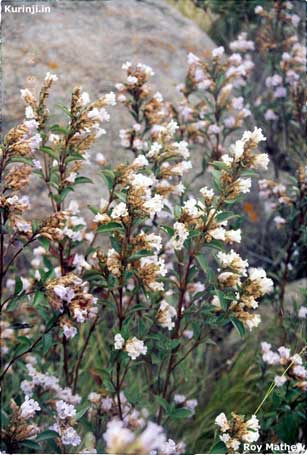 Cultural associations of kurinji
Cultural associations of kurinji
The kurinji lore is inter-twined with the lives of
tribals. Both the Muthuvas of Munnar and the Todas of Nilgiris consider
the flowering of kurinji as auspicious. However, there are taboos that
prevent them from destroying the plant or its withered twigs until the
seeds mature and disperse ten months after the flowering.
Kurinji is the flower of Lord Muruga (Murukan). The Muthuvan lore has
it that their god married Valli, a veda (tribal hunter) girl, by
weaving a garland of kurinji flowers (kurinji malar) around her neck.
For them, kurinji is the symbol of love and romance. They also
calculated their age as multiples of the flowering cycle of kurinji. The Todas do not associate kurinji with anything divine.
The Sangham classics have several references to the kurinji flowers
though some of the descriptions may be referring to flowers of karim
kurinji (the white flowers of black stalked kurinji) instead of the
neelakurinji (Strobilanthes kunthiana). Several folklores of Todas
refer to kurinji. The classical Carnatic music has a ragam (tune) named
kurinji.
In olden times, the abode of kurinji itself was referred to as kurinji.
The five physiographic divisions or ecozones of Tamilakam were referred
to as kurinji (hilly backwoods), palai (parched zone), mullai (pastoral
tract), marutam (wet-land) and neital (the littoral). This
classification also applied to areas of Kerala. (Picture shows the white variety of kurinji with the blue variety-- neelakurinji in the foreground and background.).
 Cultural associations of kurinji
Cultural associations of kurinji